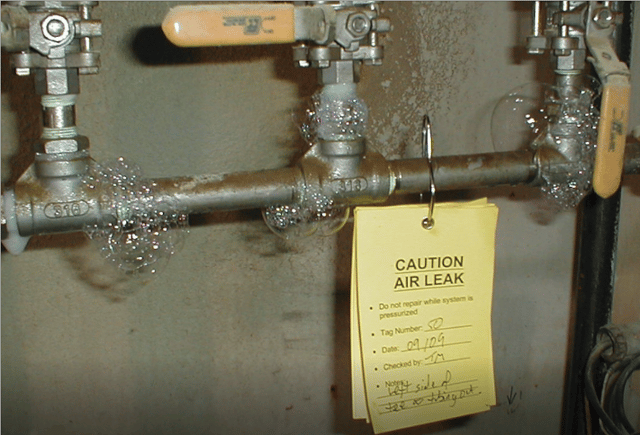Share this
Getting the Most Out of Compressed Air Systems
by Jeff Hopkins on 10/11/17 12:00 PM
The air may be free, but compressing it can be costly when your system leaks

Pictured above is a leak found at a customer site by our team. After a leak is found through the use of our ultra-sound technology, Snoop is applied to the area for visual verification. These leaks are then tagged and recorded, so you can fix them.
Learn more about the Swagelok Northern California Compressed Gas Leak Detection Program and other Energy Management Services Here >>
Least efficient utilities
Fortune magazine once described compressed air systems as "probably the least efficient utilities in manufacturing plants." The air itself may be free, but not the machinery and electricity required to keep it under pressure. Every time air leaks out of the system, more air must be squeezed back in. This is a waste of money.
A longtime customer of Swagelok once saw that their two compressors were running at capacity, and had plans to add a third. Before the addition of the third compressor this customer had their local Swagelok sales and service center check the system for leaks. So many leaks were found that once they were fixed the company didn't need to add a new compressor. In fact, they were able to take one of the existing compressors offline.
That was about 10 years ago. They still have their local Swagelok sales and service center check out the system for leaks twice a year. Altogether the company has captured more than $1 million in savings.
If you notice that your compressors are running longer without any other changes being made to the system, it's a good bet you've developed some new leaks. Even if the compressors are running the same as always, you could still have leaks. On average, uninspected systems lose 25 percent to 30 percent of their compressed air through leaks.
Three cateories of leaks
Leaks typically fall into three categories. The smallest are those that you probably didn't even know you had. Then there are leaks that you suspect but can't find on your own.
The third category is when enough air is escaping that there's no doubt about the location of the leak.
Usually we're called out because the client already knows about a large leak and while we're on site we look for all other leaks.
We find leaks through ultrasound technology. The turbulence of the leaking air creates sound waves that the human ear may not be able to detect, but our equipment can. When we find a leak, we always follow up with a visual test by putting Snoop leak detector on the area and looking for the telltale bubbles.
Fortune magazine once described compressed air systems as "probably the least efficient utilities in manufacturing plants."
On the hunt
Each time we find a leak, we list it on a spreadsheet, noting the location, severity, and the air pressure on that line and then tag it. In the course of a day we might find 100 leaks in a medium sized facility, even in operations considered "best in class." When we're done, we'll take you through the site and show you where the leaks are. We'll help you benchmark your system so that you can measure the improvement when all the leaks are fixed.
Here's a tip when you can clear your schedule to fix the leaks: If you work your way straight through from one end of the plant to the other, you probably can fix them all in one day. Too often, customers start with the worst leaks, and somehow never seem to make it all the way to the smallest ones. We know, because when we come back a year later, we see some of the previous year's tags still in place. By then, some of those small leaks aren't so small anymore.
Not just air
If it's expensive to lose air through leaks, think of how much worse it is to lose gas that must be purchased, such as helium or argon. And think of how much more dangerous a leak will be if the gas is flammable, such as hydrogen.
To get a more detailed look at the cost of leaks, download our free Hidden Costs of Leakage PDF. It presents some examples of costs associated with compressed air leakage.
Or learn more about the Swagelok Northern California Compressed Gas Leak Detection Program and other Energy Management Services
Then, contact us through our website or by calling 510-933-6200, so we can start helping you save money.
additional resources
get in touch
In a hurry or have a question? Please click here to get in touch - we respond fast! Or call 510-933-6200.
Share this
- Archive (465)
- Assembly Services (207)
- About (100)
- Seal Support Systems (96)
- Best Practices (88)
- Training Services (74)
- Fittings (51)
- Semiconductor Applications (49)
- Hoses and Flexible Tubing (47)
- Regulators (44)
- Tubing (42)
- Grab Sampling Systems (32)
- Sampling Systems (32)
- Gas Systems (30)
- Services (30)
- Downloads (29)
- Valves (24)
- Application Support (18)
- Orbital Welding (17)
- Case Studies (13)
- Steam Systems (13)
- Frequently Asked Questions (12)
- Tools (12)
- Measurement Devices (7)
- Subsystems (6)
- Thermal Management (6)
- September 2023 (1)
- August 2023 (2)
- June 2023 (1)
- March 2023 (3)
- February 2023 (3)
- January 2023 (4)
- December 2022 (4)
- November 2022 (4)
- October 2022 (4)
- September 2022 (1)
- August 2022 (3)
- July 2022 (2)
- June 2022 (4)
- May 2022 (1)
- April 2022 (2)
- March 2022 (1)
- February 2022 (2)
- January 2022 (3)
- December 2021 (1)
- November 2021 (6)
- October 2021 (6)
- September 2021 (8)
- August 2021 (4)
- July 2021 (3)
- June 2021 (6)
- May 2021 (6)
- April 2021 (7)
- March 2021 (5)
- February 2021 (4)
- January 2021 (6)
- December 2020 (5)
- November 2020 (6)
- October 2020 (6)
- September 2020 (8)
- August 2020 (7)
- July 2020 (8)
- June 2020 (8)
- May 2020 (6)
- April 2020 (9)
- March 2020 (7)
- February 2020 (10)
- January 2020 (21)
- December 2019 (23)
- November 2019 (21)
- October 2019 (22)
- September 2019 (21)
- August 2019 (22)
- July 2019 (23)
- June 2019 (20)
- May 2019 (23)
- April 2019 (22)
- March 2019 (21)
- February 2019 (20)
- January 2019 (21)
- December 2018 (14)
- November 2018 (19)
- October 2018 (23)
- September 2018 (17)
- August 2018 (29)
- July 2018 (11)
- June 2018 (6)
- May 2018 (5)
- April 2018 (4)
- March 2018 (5)
- February 2018 (3)
- January 2018 (3)
- December 2017 (2)
- November 2017 (4)
- October 2017 (3)
- September 2017 (2)
- August 2017 (6)
- July 2017 (4)
- June 2017 (4)
- May 2017 (4)
- April 2017 (3)
- March 2017 (4)
- February 2017 (3)
- January 2017 (3)
- December 2016 (3)
- November 2016 (3)
- October 2016 (3)
- September 2016 (5)
- August 2016 (5)
- July 2016 (4)
- June 2016 (5)
- May 2016 (3)
- April 2016 (4)
- March 2016 (5)
- February 2016 (11)
- January 2016 (1)
- December 2015 (3)
- November 2015 (4)
- October 2015 (3)
- September 2015 (4)
- August 2015 (4)
- July 2015 (8)
- June 2015 (5)
- May 2015 (3)
- April 2015 (4)
- March 2015 (4)
- February 2015 (3)
- January 2015 (4)
- December 2014 (2)
- November 2014 (3)
- October 2014 (4)
- September 2014 (4)
- August 2014 (4)
- July 2014 (5)
- June 2014 (4)
- May 2014 (4)
- April 2014 (5)
- March 2014 (4)
- February 2014 (3)
- January 2014 (4)
- December 2013 (5)
- November 2013 (3)
- October 2013 (4)
- September 2013 (3)
- August 2013 (5)
- July 2013 (5)
- June 2013 (5)
- May 2013 (3)
- April 2013 (6)
- March 2013 (4)
- February 2013 (4)
- January 2013 (8)
- December 2012 (4)
- November 2012 (6)
- October 2012 (6)
- September 2012 (4)
- August 2012 (4)
- July 2012 (4)
- June 2012 (4)

.webp?width=210&height=70&name=StickyLogo%20(5).webp)
